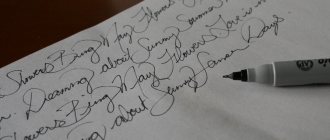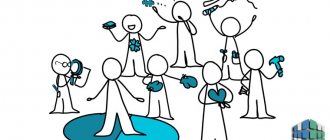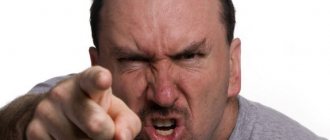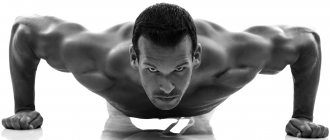Definition of the concept
The name is derived from two Greek words: physis, which means “nature,” and gnomon, which translates as “thought,” “the ability to know.” Physiognomy is a science that determines personality type, character and health characteristics by analyzing the physiological characteristics of the face. It is sometimes called the science of the face.
Ancient China is considered the birthplace of this trend. Then physiognomy came to Ancient Greece, and then spread throughout the East. In Eastern practices, physiognomy was considered as a branch of medicine. The first mentions of the physiognomy we are talking about today are found in the 6th century. BC. And the first person to use the concept of “physiognomy” is considered to be Hippocrates.
Interesting! There is still no single definition and terminological apparatus of physiognomy; it is impossible to name the pioneer of the direction. This makes some people even more doubtful about the validity and justification of this method of studying personality.
Neck laxity
The main signs of neck aging are:
- the appearance of wrinkles on the neck - “rings of Venus” (for more information about the “rings of Venus” see here);
- decreased skin elasticity;
- platysma bands.
A universal method for correcting age-related changes in the neck is biorevitalization. The technique provides instant results and a long-lasting rejuvenation effect. As a result, tissues are tightened, wrinkles are smoothed out, and the water balance in the deep layers of the skin is restored. Compositions with hyaluronic acid, antioxidants, and amino acids are widely used.
Basics of physiognomy
For physiognomic analysis, divide the face into four zones: forehead, eyes, nose, mouth and chin. In this case, pay attention only to:
- the most noticeable features - talk about character traits;
- outstanding parts - tell about human capabilities;
- symmetry and asymmetry - describe personality traits.
Each zone of the face is responsible for specific personal characteristics or spiritual qualities. Basics of physiognomy:
- Forehead. Reflects the intellectual, ethical and ethical development of a person, as well as ideology and philosophy of life. A wide and high forehead means great intellectual potential and multiple talents. A very high forehead combined with an elongated face means rigidity and a tendency to violence. A short and narrow forehead is a sign of hard work, homeliness, and developed will. A correct, proportional forehead is a sign of spiritual harmony and physical health.
- Eyes. Reflect the creativity and spirituality of a person. Big eyes are a trait of leaders and sensitive people. Bug-eyedness is a sign of slowness and laziness. Deep-set eyes are a sign of cunning, resentment, and anger. Close-set eyes are a sign of duality of character (like two people in one). Deep and close-set eyes are a symbol of criminal tendencies.
- Nose. Tells about the activity and willpower of the subject. A straight nose of medium length is a feature of gentle, hardworking people with high adaptive abilities. The hump is a trait of intellectuals, exalted people, vulnerable to the passions of love. An upturned tip of the nose is a feature of light and frivolous people, cheerful, perky, and sometimes naive. A pronounced rise of the tip of the nose is a propensity to take risks and courage. A crooked nose is a sign of hypocrisy. A long and sharp nose is a symbol of cunning.
- Mouth and chin. Harmony and proportionality in this zone speaks of the mental stability and balance of the subject. A big mouth is a symbol of courage and deceit. A small mouth is a trait of indecisive, cowardly people. Tightly pursed lips are a trait of tough, strong-willed people. A drooping lower jaw is a sign of problems with mental, physical, and intellectual development. A large, wide chin is a symbol of a steely character. A poorly defined chin is a sign of weakness. A dimple on the chin and a heavy lower jaw are a symbol of passion.
According to other studies, physiognomists study five elements: mouth, eyes, eyebrows, nose, ears. In books and on the Internet there are different versions of the basics of reading people by appearance. It is no longer possible to say exactly which approach is primary and correct. One thing is certain: physiognomic analysis of the face is carried out from general to specific, that is, first we study the shape of the face and profile, and then individual elements (eyes, nose, etc.).
Note! As S. Freud said, sometimes a cigar is just a cigar. In the case of physiognomy, this statement is also true. You cannot judge a person solely by appearance. Often, analysis of individual external features gives a very contradictory overall picture.
For what purposes is physiognomy necessary?
Knowledge of the basics of physiognomy will be useful to people in everyday life and at work. Is it unpleasant, when meeting a person, to mentally draw up a portrait of him and begin selecting an approach for building relationships? In addition, criminologists, psychologists, and psychiatrists often turn to physiognomy. Researchers are still trying to find a connection between mental disorders, criminal behavior and external characteristics. For example, studies are being conducted on the topic “Do serial maniacs have similar external, anatomical features?”
How can you develop a magnetic gaze?
Let's say you have a meeting with someone you don't like. He is hot-tempered, arrogant, stubborn, has a very high opinion of his own merits, does not tolerate the opinions of others, and suppresses everyone with his high official position. Perhaps it will even be your tyrant boss (this happened in your life, bad luck!), and he called you for another scolding, which he always succeeded in, and he (not only with you) really enjoys such moments. You can put an end to these pleasures. With just his magnetic gaze. Yes Yes.
How can you develop a magnetic gaze, and how to use this “secret weapon”?
During a conversation, look between your boss’s eyes, i.e., at the bridge of his nose. At the same time, imagine that you see a small dot there and you know the weak side of this person’s character (all such people are generally weak and worthy of contempt).
So, talk to this person and calmly observe the point between his eyes. Don't look at him gloomily and point-blank. You will soon notice how his eyes begin to dart restlessly. But when he starts talking, don't look at him. Consider, for example, his clothes, hairstyle, hands, in a word, whatever you want, just don’t look into his eyes. Listen to him calmly, attentively, do not rush into a quarrel, especially do not show that you wavered or were afraid. But as soon as you start talking again, you again look between his eyes at an imaginary small dot. Calmness and such a look (it will seem to your interlocutor that you are looking straight into his eyes, looking inexorably, firmly, as they say, seeing right through him) are the basis of your behavior in this situation.
Result? Several such meetings, and your tyrant boss will be broken.
You won. First your own insecurity, and then someone else’s arrogance. And almost with one glance.
The meaning of facial shapes and profiles
Personality characteristics of people depending on their face shape:
- Oval. A trait of impulsive people. At the same time, great intellectual potential and the ability to learn are noticeable. However, when these elements are combined, that is, when they are obsessed with something, people with an oval face shape are at risk for psycho-emotional exhaustion and burnout. Another distinctive feature of this type is love of freedom and independence. Such people do not like to obey. As a rule, representatives of this type find themselves in creative professions. However, sometimes they lack perseverance, perseverance, and seriousness in order to complete the work they have begun.
- Circle. Impulsiveness, energy, initiative, thirst for power are the main features of this type. These are noble, positive and kind people. They easily perceive failures and find a way out of difficult situations, quickly adapting to changing conditions. Such people constantly generate ideas, but they do not always have the patience to carefully think through plans and prepare for their implementation. Sometimes they act rashly and take risks. Representatives of this type find themselves in leadership positions.
- Trapezoid. Reasonable and rational type. He evaluates everything from the point of view of practicality, does not like those who have their head in the clouds and do not know how to indulge in fantasies. He is distrustful of new things, does not like changes, adapts poorly and is reluctant to change himself and his life. Rationalism sometimes transforms into self-interest. However, at the same time, they are sociable and friendly people. They make excellent careerists.
- Triangle. Unbalanced type. The mood changes almost every minute. Noticeable are outstanding intellectual abilities, good memory, originality of thinking, an excellent sense of humor, and good oratory skills. In life he is guided only by personal desires, sometimes he acts irrationally. This is a sensual type who does not tolerate monotony and boredom. Emotions and constant striving for something (often something unattainable) are important to him. There is a noticeable increased tendency to reflect. The thinner the face and the tighter the skin, the more contradictory the character.
- Rectangle or square. People with this face are leaders with a keen sense of justice. They know and accept themselves, they are distinguished by perseverance and determination. They can be cruel, but they are always fair. They do not like to rant; they prefer actions and laconic statements. They are developed physically and intellectually, and are distinguished by a high level of erudition. They always maintain a sober mind and are able to convincingly prove their point of view. Despite all this, they can be passionate, quick-tempered, emotional and overly frank in relationships with friends and loved ones.
- Elongated shape. Such people always achieve success in everything. They are active and comprehensively developed, hardy and decisive. They know their worth and are confident that they deserve more and better.
Personality features based on the shape of the face profile:
- Convex. Such a person always has a lot of ideas. He enthusiastically takes on the implementation of plans, but does not always notice that the ideas are far from reality and are more like dreams. Due to excessive activity, it can be difficult for such people to concentrate on one thing. In relationships, they prefer to tell rather than listen.
- Straight. These are stubborn and self-confident people. At the same time, they are distinguished by restraint and rationality. They like to understand the essence of things, they are used to being winners. They are not used to being content with little, they are always on the move, searching for a better life.
- Concave. People with such a face are characterized by isolation and pessimistic views of the world. From the outside it seems that such a person constantly thinks “about the great.” And this is partly true. Such people are indeed often self-absorbed, but they think about some trifles and tend to exaggerate problems.
Other profile features and their meaning:
- the forehead protrudes - a feature of active, positive and enterprising people, creative individuals;
- the nose protrudes - a sign of pronounced skepticism in everything and distrust as a leading personality trait;
- the mouth protrudes - a symbol of the fact that it is important for a person to enjoy everything he does;
- sharp facial features, angular profile - a sign of intelligence, insight, high adaptive abilities and developed logical thinking;
- a rounded profile is a symbol of prudence and restraint, caution in decision making (it is important not to confuse it with indecisiveness).
What does a person's eye color mean?
Green eyes are the eyes of tenderness, loyal and reliable people (which is especially true for women). At the same time, these are the eyes of people in need of love.
Dark brown eye color means that a person acts mainly spontaneously (under the influence of feelings). Such people have absolutely no idea what they want, particularly in love.
Gray eyes are the eyes of people who quickly respond to changing situations and overcome any difficulties. These are the eyes of inquisitive people, they can easily bewitch when they want to.
Light brown eyes are the eyes of people who obey reason rather than feelings. Usually light brown eyes belong to strong personalities. But very often, behind a stern appearance, a gentle, sensitive nature and great warmth are hidden.
Blue eyes are deceptive; most often you want to find dreaminess and naivety in them. But in fact, the opposite is true: these are the eyes of people who persistently achieve their goals, relying more on reason than on intuition. But in love, such eyes attract you, and they cannot be forgotten.
Black eyes mean that a person has a passionate temperament. Often such eyes belong to rather nervous people. They command, but without rudeness. If they want something, nothing will stop them, they are ready to do anything in the name of protecting their happiness or their love.
Character traits by appearance
In physiognomy, there are several approaches to studying character by appearance:
- Some experts believe that attention should only be paid to anatomical features.
- Other physiognomists suggest assessing the shape and profile of the face, the main areas (eyes, eyebrows, nose, lips, chin).
- The third group of specialists suggests paying attention not only to anatomical features, but also to facial wrinkles. According to physiognomy, age leaves its signs on the face. The fact is that the more often a person experiences some emotion, the more his face takes it on as a “mask”. In addition, physiognomists from this group recommend paying attention to gait, body position, gestures, eye color, that is, assessing the entire appearance and using it to talk about leading character traits.
In this article we will look at the meaning of the main zones and shape of the face.
The meaning of eyebrow and eye shape
Personality characteristics based on eyebrow shape:
- Unibrow. Such a person is distinguished by determination, expressiveness, straightforwardness, and resourcefulness. If there is a mole on the unibrow (anywhere), then this is a sign that the person will have success in life.
- Smooth bend. This is a symbol of curiosity, a thirst for knowledge.
- Torn eyebrow (scar does not count). This is a sign of tyranny and treachery.
- The eyebrow looks like a boomerang. This speaks of the highest degree of creativity, the ability to invent something, to create.
- Straight eyebrow. Such a person is distinguished by a great love of life and activity.
- The eyebrow is like an arc or arch. This is a symbol of developed imagination and originality.
- Far set eyebrows. A sign of a person's suggestibility. At the same time, this indicates a developed ability to easily adapt to changing conditions.
Important! Most women and some men arbitrarily adjust the shape of their eyebrows. Keep this in mind when you analyze someone's face. Only those judgments that relate to the natural growth of eyebrows are fair.
Physiognomy of the eyes in men and women:
- Big eyes. A symbol of sensuality and a heightened thirst for power.
- Small eyes. This feature is characteristic of jealous and stubborn people.
- The outer corner of the eye is downward. Characteristics of kind, attentive, positive people.
- The outer corner of the eye is raised up. A sign of determination and courage.
- Elongated eye. Speaks of extraordinary abilities and a high level of intelligence.
- Cat's eye. Characteristics of greedy and brave people. Sometimes courage borders on recklessness.
- The inner corner faces down. Symbol of submission.
The meaning of lip shape
Physiognomy of lips in women and men:
- big mouth - a person is ruled by desires and the idea of pleasure;
- plump lips are a symbol of sensuality and methodical views;
- string lips - signal the toughness and cruelty of a person;
- a narrow mouth is a sign of emotional restraint, excessive seriousness;
- uneven lips are a symbol of inconstancy, inconsistency, and variability of the owner’s character;
- straight lips are a sign of a developed ability for self-regulation;
- the upper plump lip and the lower thin one are a symbol of suspiciousness and vanity;
- the lower lip is plump and the upper lip is thin - a sign of restraint and delicacy in everything, but at the same time selfishness;
- lips with different levels of corners are a sign of a liar.
As with eyebrows, women's lips can be far from their natural shape. Keep this in mind during diagnosis. Otherwise, the physiognomy of a man’s face and the physiognomy of a woman’s face are no different.
The meaning of the chin shape
Personality features based on chin shape:
- sharp - a symbol of cunning, but at the same time tact;
- round is a sign of composure, developed organizational skills, but at the same time it indicates a soft character;
- oval is a trait of aesthetes and those who love adventure and love life;
- square is a symbol of a strong spirit, steely character and craving for power.
Note! The human face transforms throughout an individual’s life, that is, at different ages different characteristics can be drawn about the same person, although by and large the leading features of his personality remain unchanged. This makes us once again doubt the validity and scientific nature of the physiognomy method.
Distance between people of different heights when communicating
A group of psychologists, after conducting a series of experiments, found that there is a clear connection between the “conversation distance” and the height of the interlocutor. Namely: the taller a man is, the closer he comes to his interlocutor, and, conversely, the shorter he is, the further he prefers to be from his interlocutor. In women, the opposite relationship was observed.
This distance between people when communicating is explained quite simply: in our society, a kind of “cultural norm” has been created - a man should be tall, and a woman, on the contrary, should be petite. And although in reality this is not always the case, we all unconsciously try to make life fit the theory. Therefore, a tall man is pleased to stand next to his interlocutor, while a tall woman, on the contrary, tends to move away to hide her “flaw.”
It follows, in particular, that you should not approach a tall interlocutor or a short interlocutor during a conversation - they will feel awkward. And in the same way, do not miss the opportunity to please the person - come almost close to a miniature woman or a tall man: let the absence or presence of an extra 10 cm of height bring them joy and pleasure.
Analysis of faces using the example of famous women and men
Let's look at the physiognomy of the faces and characters of men and women in pictures using photographs of famous people as examples.
Photo No. 1 Angelina Jolie
A very interesting face from a physiognomy point of view. The face shape is square. Leading features: cheekbones, that is, a massive lower part of the face, plump lips. What does this mean? Jolie is a leader and a person with a keen sense of justice. This is reflected in her volunteer and charitable activities. At the same time, he is a sensual and passionate person.
Photo #2 Megan Fox
The face shape is oval. Protruding facial features: nose and lips. The outer corners of the eyes are raised up, and the inner corners are slightly lowered (perhaps the shape has been changed by makeup, for the same reason we are not considering eyebrows). The shape of the eyes speaks of determination and strength of character, but at the same time of humility (can be seen as wisdom, cunning). The shape of the face speaks of independence, impulsiveness, and originality. Probably all this helped Megan become a successful actress. What else? The lower lip is slightly larger than the upper, which speaks of sensuality and selfishness. The shape of the nose once again reminds of the activity and strong character of the subject.
Photo #3 Woody Harrelson
Another very unusual and interesting face from the point of view of physiognomy. The face shape is rectangle. Prominent features: cleft chin, wide cheekbones, sharp nose with a downward tip and slight curvature, thin pursed lips. What does all of this mean? Before us is a fair but tough man, a leader. Despite all his enthusiasm, he knows how to keep his emotions under control and regulate his behavior depending on the conditions. The massive lower part of the face and the cleft chin once again emphasize the strength of character and speak of masculinity, courage, and determination. However, the shape of the nose hints at the subject's cunning and hypocrisy.
Photo #4 Hugh Laurie
The face shape is an inverted triangle (refers to a trapezoid in our classification). Outstanding features: sharp chin, thin asymmetrical lips, even and regular shape of eyebrows and eyes. What does this mean? Before us is a comprehensively developed and harmonious personality. It perfectly combines sensuality and rationality. The shape of the eyes indicates that a person lives in harmony with himself. The chin speaks of tact and cunning. Although we said that in this article we will not touch upon facial changes, we cannot help but say here: the corner of the lips is turned up and tends to a skeptical grin. In real life, the actor probably resembles his iconic character, Dr. House.
Photo #5 Nicolas Cage
Try to make a portrait of this person yourself. What do you think is the physiognomy of his face?
Additionally, we recommend that you read the book by L.P. Parshukova and Z.A. Shakurova “Physiognomy: read the face.” Suitable for beginner physiognomists. The book presents learning in pictures. There you will find diagrams for studying faces and examples of character descriptions. After reading the book, you will be able to read the face of any man and any woman. You will also be able to conduct self-analysis and determine your strengths and weaknesses.
Important! Remember that for a more accurate diagnosis you need to examine the face from all sides. It is also important to remember that the face changes greatly depending on a person’s weight.
Afterword
You can use physiognomy anywhere: hiring, entering into a relationship, psychological correction, crime analysis. And the examples described are only a small and pathetic part of all science, or rather art. Physiognomy finds answers to where a person himself is not aware of the true motives of his actions. At the same time, physiognomy will tell us about a person’s inclinations and abilities.
Most often, genetic inclinations manifest themselves in emergency situations. It is enough to recall the description of the appearance of any historical figure and compare it with what physiognomy says. And then compare the description of his activities and actions.
It is better to build a personality portrait gradually, putting it together like a puzzle. And of course, one cannot be categorical about interpretations. You should always remember to constantly monitor and take into account external factors.
Psychologist, ex-special services officer Artem Pavlov, as part of the TV show “Calendar,” spoke about what physiognomy is and how to use it.











